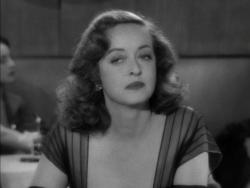Article
A Tribute to Bette Davis
Written by Patrick
First Posted: April 1st, 2004

The great Bette Davis' career as a movie star remains unparalleled by any other female star. From her first screen appearance in 1931's Bad Sister to her last in Wicked Stepmother in 1988 she never stopped working (or smoking). She appeared in a total of 87 theatrical features, add in her made for television movies and her total filmed roles surpasses one hundred. This is approximately twice the output of her chief rival for greatest female movie star of all time status, Katharine Hepburn. And unlike Hepburn, who rarely carried a movie on her own, nearly every Bette Davis picture was a vehicle designed and built around her.
She created many varied and Iconic characters. But she was always at her best when she played the bitch. The opening scene in The Letter (1940) is a signature Davis moment and one that the proper Miss Hepburn could never have pulled off. We see Leslie Crosbie come out her front door repeatedly firing a pistol at a man (her lover who had the nerve to spurn her). She calmly keeps walking towards him as he staggers down the porch steps, pumping round after round into his body. In The Little Foxes she tells her invalid husband, in a voice dripping with venom, 'I hope you die. I hope you die soon. I'll be waiting for you to die.' In In This Our Life (1942) she runs off with her sister's fiance, drives him to booze and then suicide, and then she kills a young girl in a hit-and-run accident and tries to pin it on an innocent black youth. Nobody played bad better than Bette.
Of course her two most famous roles are as Margo-Fasten your seatbelts, it's going to be a bumpy night-Channing, in All About Eve and as Baby Jane-You didn't eat your din din-Hudson, in What Ever Happened to Baby Jane?. Other memorable movies include Of Human Bondage (1934), Dangerous (1935), The Petrified Forest (1936), Jezebel (1938), Dark Victory (1939), The Old Maid (1939), Now, Voyager (1942), Watch On the Rhine (1943), Mr. Skeffington (1944), The Corn is Green (1945), Beyond the Forest (1949), The Star (1952), The Virgin Queen (1955), Pocketful of Miracles (1961), Hush...Hush, Sweet Charlotte (1964), Death on the Nile (1978), The Whales of August (1987) and many others.
Her accolades and achievements speak for themselves. She twice won the Best Actress Oscar and was the first actress to be nominated ten times. In fact from 1938 to 1942 she was nominated for Best Actress five consecutive years. She was also ranked as the top female box office star for the years 1940 and 1941. She served as President of the Screen Actors Guild, was instrumental in creating the Hollywood Canteen that entertained thousands of G.I.'s during World War II and was so powerful a force at her studio that she was often referred to as the 'fifth' Warner brother. In the nineteen-seventies when the American Film Institute began handing out Lifetime Achievement Awards Bette Davis was the very first woman and only the fifth person to be so honored. A whole new generation of fans became aware of her in 1983 when singer Kim Carnes had a number one pop hit with a song called 'Bette Davis Eyes'. Like Cagney and Bogart she is one of the few classic stars that can be easily recognized by a simple impersonation. To do Bette you need only puff on a fake cigarette, roll your arm around in a circle and say 'Petah'.
Bette Davis was not a natural beauty or a glamour queen, but this only makes her remarkable talent and career that much more impressive. She once said, 'Until you're known in my profession as a monster, you're not a star.'
